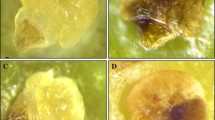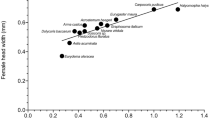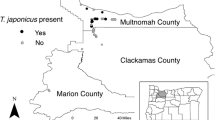Abstract
Habrobracon hebetor (Hymenoptera: Braconidae) is a parasitoid that interferes with the rearing and mass production of Anagasta (= Ephestia) kuehniella, causing economic losses to laboratories and research centers. Although H. hebetor can parasitize insect crop pests, a lack of information on its parasitoid activity on different hosts limits understanding of the paralyzing process, which involves injection of venom to induce host paralysis. We investigated whether hosts selected according to the efficiency of paralysis by H. hebetor were effectively parasitized. We performed an experiment offering 13 different insect pest species from four families (Pyralidae, Erebidae, Noctuidae, and Crambidae) to H. hebetor. We selected the four hosts that were paralyzed in the highest proportions and most rapidly: Diatraea saccharalis, Agrotis ipsilon, Spodoptera cosmioides, and A. kuehniella. We investigated parasitism by H. hebetor, based on the biological parameters of the ectoparasitoid on each host and the respective functional response models. We observed a type II functional response for all alternative hosts tested, which is usual in parasitoid-host relationships. However, H. hebetor was not able to complete its life cycle on A. ipsilon, indicating that paralysis efficacy is a poor criterion to identify potential hosts for parasitism. In the other words, the viability of H. hebetor and the attack rate were highest on D. saccharalis, indicating that this natural enemy might be useful for the biological control of this pest.


Similar content being viewed by others
References
Akinkurolere RO, Boyer S, Chen H, Zhang H (2009) Parasitism and host location preference in Habrobracon hebetor (Hymenoptera: Braconidae): role of refuge, choice, and host instar. J Econ Entomol 102(2):610–615
Ayala A, Pérez-Lachaud G, Toledo J, Liedo P, Montoya P (2018) Host acceptance by three native braconid parasitoid species attacking larvae of the Mexican fruit fly, Anastrepha ludens (Diptera, Tephritidae). J Hymenopt Res 63:33–49
Ba MN, Baoua IB, N’Diaye M, Dabire-Binso C, Sanon A, Tamò M (2013) Biological control of the millet head miner Heliocheilus albipunctella in the Sahelian region by augmentative releases of the parasitoid wasp Habrobracon hebetor: effectiveness and farmers’ perceptions. Phytoparasitica 41(5):569–576
Baoua IB, Ba MN, Amadou L, Kabore A, Dabire-Binso CL (2018) Field dispersal of the parasitoid wasp Habrobracon hebetor (Hymenoptera: Braconidae) following augmentative release against the millet head miner Heliocheilus albipunctella (Lepidoptera: Noctuidae) in the Sahel. Biocontrol Sci Technol 28(4):404–415
Beard RL (1972) Effectiveness of paralyzing venom and its relation to host discrimination by braconid wasps. Ann Entomol Soc Am 65(1):90–93
Bernardi EB, Haddad ML, Parra JRP (2000) Comparison of artificial diets for rearing Corcyra cephalonica (Stainton, 1865) (Lepidoptera: Pyralidae) for Trichogramma mass production. Rev Bras Biol 60(1):45–52
Bézier A, Louis F, Jancek S, Periquet G, Thézé J, Gyapay G, Musset K, Lesobre J, Lenoble P, Dupuy C, Gundersen-Rindal D, Herniou EA, Drezen JM (2013) Functional endogenous viral elements in the genome of the parasitoid wasp Cotesia congregata: insights into the evolutionary dynamics of bracoviruses. Philos Trans R Soc B 368(1626):20130047
Borzoui E, Naseri B, Mohammadzadeh-Bidarani M (2016) Adaptation of Habrobracon hebetor (Hymenoptera: Braconidae) to rearing on Ephestia kuehniella (Lepidoptera: Pyralidae) and Helicoverpa armigera (Lepidoptera: Noctuidae). J Insect Sci 16(1):12
Burr IW, Foster LA (1972) A test for equality of variances. In: Mimeo Series No. 282. University of Purdue, West Lafayette
Cantori LV (2019) Potencial do ectoparasitoide Habrobracon hebetor Say, 1857 (Hymenoptera: Braconidae) para controle biológico de treze espécies de lepidópteros-praga. Master’s thesis, Escola Superior de Agricultura Luiz de Queiroz, Universidade de São Paulo
Castilho HJ, Botelho PSM, Almeida LC, Araújo JR (1987) Testes com Habrobracon hebetor (Say) (Hymenoptera: Braconidae) para o controle biológico da espécie da cana-de-açúcar Diatraea saccharalis (F.). In: Resumos do congresso brasileiro de entomologia, vol 1:11. SEB, Campinas
Darwish E, El-Shalzy M, El-Sherif H (2003) The choice of probing sites by Bracon hebetor Say (Hymenoptera: Braconidae) foraging of Ephestia kuehniella Zeller (Lepidoptera: Pyralidae). J Stored Prod Res 39:265–276
Drezen JM, Leobold M, Bézier A, Huguet E, Volkoff AN, Herniou EA (2017) Endogenous viruses of parasitic wasps: variations on a common theme. Curr Opin Virol 25:41–48
Fernández-Arhex V, Corley JC (2003) The functional response of parasitoids and its implications for biological control. Biocontrol Sci Technol 13(4):403–413
Gallo D, Nakano O, Silveira Neto S, Carvalho RPL, Baptista GC, Berti Filho E, Parra JRP, Zucchi RA, Alves SB, Vendramim JD, Marchini LC, Lopes JRS, Omoto C (2002) Entomologia agrícola. Fealq, Piracicaba
Greene GL, Leppla NC, Dickerson WA (1976) Velvetbean caterpillar: a rearing procedure and artificial medium. J Econ Entomol 69(4):487–488
Hagstrum DW (1983) Self-provisioning with paralyzed hosts and age, density, and concealment of hosts as factors influencing parasitization of Ephestia cautella (Walker) (Lepidoptera: Pyralidae) by Bracon hebetor Say (Hymenoptera: Braconidae). Environ Entomol 12:1727–1732
Hassan M, Hasan M, Khatun R, Hossain A, Athanassiou CG, Bari A (2020) Mating attributes relating to parasitization and productivity in Habrobracon hebetor (Hymenoptera: Braconidae) rearing on host Indian meal moth (Lepidoptera: Pyralidae). J Econ Entomol 113(3):1528–1534
Hensley SD, Hammond AH Jr (1968) Laboratory techniques for rearing the sugar cane borer on an artificial diet. J Econ Entomol 61(6):1742–1743
Herniou EA, Huguet E, Thézé J, Bézie A, Periquet G, Drezen J-M (2013) When parasitic wasps hijacked viruses: genomic and functional evolution of polydnaviruses. Philos Trans R Soc B 368(1626):20130051
Jarrahi A, Safavi SA (2016) Effects of pupal treatment with Proteus® and Metarhizium anisopliae sensu lato on functional response of Habrobracon hebetor parasitising Helicoverpa armigera in an enclosed experiment system. Biocontrol Sci Technol 26(2):206–216
Kabore A, Ba NM, Dabire-Binso CL, Sanon A (2017) Field persistence of Habrobracon hebetor (Say) (Hymenoptera: Braconidae) following augmentative releases against the millet head miner, Heliocheilus albipunctella (de Joannis) (Lepidoptera: Noctuidae), in the Sahel. Biol Control 108:64–69
Libersat F, Delago A, Gal R (2009) Manipulation of host behavior by parasitic insects and insect parasites. Annu Rev Entomol 54:189–207
Magro SR, Parra JRP (2001) Biologia do ectoparasitoide Bracon hebetor Say, 1857 (Hymenoptera: Braconidae) em sete espécies de lepidópteros. Sci Agric 58(4):693–698
Magro SR, Dias AB, Terra WR, Parra JRP (2006) Biological, nutritional, and histochemical basis for improving an artificial diet for Bracon hebetor Say (Hymenoptera: Braconidae). Neotrop Entomol 35(2):215–222
Mahdavi V, Saber M (2013) Functional response of Habrobracon hebetor Say (Hym.: Braconidae) to Mediterranean flour moth (Anagasta kuehniella Zeller) in response to pesticides. J Plant Prot Res 53(4):399–403
Matthews RW (1974) Biology of Braconidae. Annu Rev Entomol 19:15–32
Mostaghimi N, Fathi SAA, Ghanbalani GN (2010) Functional response of Habrobracon hebetor (Say) (Hym.: Braconidae) to various densities of two hosts, Ephestia kuehniella Zeller and Plodia interpunctella Hubner (Lepidoptera: Pyralidae). Iran J Plant Prot Sci 41(1):1–8
Papanikolaou NE, Milonas PG, Demiris N, Papachristos DP, Matsinos YG (2014) Digestion limits the functional response of an aphidophagous coccinellid (Coleoptera: Coccinellidae). Ann Entomol Soc Am 107:468–474
Parra JRP (1997). In: Parra JRP, Zucchi RA (eds) Trichogrammae o controle biológico aplicado, vol 4. Fealq, Piracicaba, pp 121–150
Parra JRP (2014) Biological control in Brazil: an overview. Sci Agric 71(5):345–355
Parra JRP, Zucchi RA (1997) Trichogramma e o controle biológico aplicado. Fealq/Esalq/USP/Departamento de Entomologia, Piracicaba, São Paulo
Parra JRP, Coelho Junior A (2019) Applied biological control in Brazil: from laboratory assays to field application. J Insect Sci 19(2):1–6
Parra JRP, Lopes JRS, Serra HJP, Sales Júnior O (1989) Metodologia de criação de Anagasta kuehniella (Zeller, 1879) para produção massal de Trichogramma spp. An Soc Entomol Bras 18(2):403–415
Parra JRP, Vinson SB, Gomes SM, Cônsoli FL (1996) Flight response of Habrobracon hebetor (Say) (Hymenoptera: Braconidae) in a wind tunnel to volatiles associated with infestations of Ephestia kuehniella Zeller (Lepidoptera: Pyralidae). Biol Control 6(2):143–150
Payne NM (1934) The differential effect of environmental factors upon Microbracon hebetor Say (Hymenoptera: Braconidae) and its host, Ephestia kuehniella Zeller (Lepidoptera: Pyralidae) II. Ecol Monogr 4(1):1–46
Pezzini C, Mundstock JS, Kohler A (2020) Influence of a diet containing tobacco on the biology of Ephestia kuehniella (Lepidoptera: Pyralidae) and its parasitoid Habrobracon hebetor (Hymenoptera: Braconidae). Eur J Entomol 117:190–198
Pritchard DW, Paterson R, Bovy HC, Barrios-O’Neill D (2017) FRAIR: an R package for fitting and comparing consumer functional responses. Methods Ecol Evol 8(11):1528–1534
R Core Team (2019) R: a language and environment for statistical computing. R Foundation for Statistical Computing, Vienna. https://www.r-project.org/
Rashidi F, Nouri-Ganbalani G, Imani S (2018) Sublethal effects of some insecticides on functional response of Habrobracon hebetor (Hymenoptera: Braconidae) when reared on two lepidopteran hosts. J Econ Entomol 111(3):1104–1111
Richards OW, Thomson WS (1932) A contribution to the study of the genera Ephestia, Gn. (including Strymax, Dyar), and Plodia, Gn. (Lepidoptera: Phycitidae), with notes on parasites of the larvae. Trans R Entomol Soc Lond 80(2):169–247
Serra HJP (1992) Bioecologia do ectoparasitoide Habrobracon hebetor (Say, 1836) (Hymenoptera: Braconidae) em Anagasta kuehniella (Zeller, 1879) (Lepidoptera: Pyralidae). Master’s Thesis, Escola Superior de Agricultura Luiz de Queiroz, Universidade de São Paulo
Shapiro SS, Wilk MB (1965) An analysis of variance test for normality. Biometrika 52:591–611
Soliman HS (1940) Studies in the biology of Microbracon hebetor Say (Hymenoptera: Braconidae). Bull Soc Fouad Premier D’Entomol 24:215–247
Solis MA (2007) Phylogenetic studies and modern classification of the Pyraloidea (Lepidoptera). Rev Colomb Entomol 33(1):1–9
Ullyett GC (1945) Distribution of progeny by Microbracon hebetor Say. J Entomol Soc South Afr 8:123–131
Yu SH, Ryoo MI, Na JH, Choi WI (2003) Effect of host density on egg dispersion and the sex ratio of progeny of Bracon hebetor (Hym.: Braconidae). J Stored Prod Res 39(4):385–393
Acknowledgements
We thank the Laboratory of Insect Biology in the Department of Entomology and Acarology (USP/ESALQ), especially the technician Neide Zerio for helping with insect rearing. Adriano Garcia Gomes holds a fellowship awarded by FAPESP (2019/26071-8). We also thank SPARCBio (São Paulo Advanced Research Center for Biological Control) (FAPESP-Koppert, 2018/02317-5). We extend our thanks to Janet W. Reid (JWR Associates) for the English revision.
Author information
Authors and Affiliations
Contributions
LVC designed and performed the experiments. AGG and WACG performed statistical and ecological analyses. ASP supported the experimental studies. JRPP designed and supervised the study. All authors participated in discussing the results and writing the manuscript.
Corresponding author
Ethics declarations
Conflict of interest
The authors declare that they have no competing interests.
Research involving human and/or animal participants
The research did not involve humans or animals.
Additional information
Handling Editor: Josep Anton Jaques Miret
Rights and permissions
Springer Nature or its licensor holds exclusive rights to this article under a publishing agreement with the author(s) or other rightsholder(s); author self-archiving of the accepted manuscript version of this article is solely governed by the terms of such publishing agreement and applicable law.
About this article
Cite this article
Cantori, L.V., Garcia, A.G., Pinto, A.S. et al. Detailed look at paralysis of hosts by the ectoparasitoid Habrobracon hebetor (Hymenoptera: Braconidae): does more efficient paralysis mean more effective parasitism?. BioControl 67, 555–562 (2022). https://doi.org/10.1007/s10526-022-10165-3
Received:
Accepted:
Published:
Issue Date:
DOI: https://doi.org/10.1007/s10526-022-10165-3




